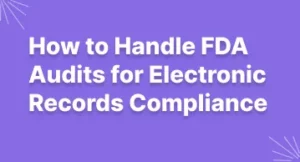Dive Deeper Into Risk Management for Medical Device Startups
Introduction
Risk management is an essential part of any business, and medical device startups are no exception. Without effective risk management, medical device startups can face serious financial, legal, operational, and reputational risks.
This practical guide will provide medical device startups with the information needed to implement an effective risk management strategy. It will cover everything from initial risk assessments, to regulatory requirements, analyzing risks, documentation, reporting, internal audits, and more.
Throughout this guide, you will find useful information about the importance of risk management in medical device startups, as well as specific strategies, processes and procedures to help you stay compliant and reduce risks for your business.
Let’s get started!
Initial Risk Assessments
An essential part of implementing risk management for medical device startups is conducting initial risk assessments. These assessments should include identifying the potential risks associated with a product, outlining the scope and objectives of the assessment, and assigning roles and responsibilities to the stakeholders involved.
To identify potential risk points, the team should thoroughly examine the product concept, design, development process, production process, packaging, marketing, distribution, and use. Any areas where there is potential for error or which can lead to the product malfunctioning should be noted and documented.
The scope and objectives of the assessment should be outlined in detail, specifying which parts of the product are being inspected, what data needs to be collected, and how the data will be analysed. It’s important to have a clear understanding of what is being tested and the purpose of the assessment.
The stakeholders involved in the assessment should be determined and their roles and responsibilities should be clearly documented. This includes the person responsible for managing the assessment, collecting the data, analysing the results, and making decisions about the product.
Regulatory Requirements
It is essential for medical device startups to meet all relevant regulatory requirements when it comes to risk management. This can involve staying up-to-date with the latest laws and regulations set out by governmental bodies. For example, the EU’s Medical Device Regulation (MDR) sets out specific requirements that should be followed when operating on the European market.
At a more local level, there are often additional guidelines and procedures that should be taken into account. It is important to research any applicable regulations in the country or countries where the startup is operating and ensure that these are followed.
To help support and guide compliance with the relevant regulations, it is always beneficial to have access to experienced advisors and industry experts who can provide advice and assistance on how best to adhere to the set standards.
Risk Containment Measures
When it comes to risk management, it’s essential to have measures in place to contain risks and ensure the safety of medical device startups. Some potential methods for containing risks include technology, process design, system segregation, and user training.
The use of technology can help contain risks by providing automated features that support efficient workflows and reduce the likelihood of errors. Process design can be used to enhance workflow efficiency and eliminate unnecessary steps. System segregation and user training are also effective ways of containing risks, as they allow for better management of company assets and data while ensuring team members are well-equipped to deal with any potential threats.
Taking the time to understand the measures that can be used to contain risk will help medical device startups operate in a safe and secure environment.
Analyzing risks is essential to ensure that the medical device startup is compliant with all necessary safety requirements. It is important to periodically review risk assessment processes, and any changes that may increase or decrease the risk level should be noted.
Risk management should involve a comprehensive review of processes, procedures, and any changes to the environment that would affect the potential risks. For example, this could involve assessing the impact of new technology or changes to the operational structure.
The risk assessment process should involve identifying risk points, and evaluating their probability of occurrence. This should be done keeping in mind the needs of the organization, and taking into account the potential costs associated with not managing the risks properly. Once the risk points have been identified, the responsible stakeholders should decide how to mitigate the risks, usually by implementing a containment measure.
It is also important to record all the decisions made regarding risk management. This is to ensure that the correct measures are being taken to minimize risks and are documented for future reference.
Finally, an internal audit should be conducted on a regular basis to make sure that risk management procedures are being implemented correctly. The audit should include both a review of documentation and a physical review of the environment. Internal audits can help identify any areas of risk that may have been overlooked or any changes that can be made to improve the current risk management process.
Documenting processes, actions taken, and outcomes of risk management efforts is a crucial component of successful risk management for medical device startups. Proper documentation helps ensure that risks are understood and managed effectively, keeping track of how risks have been addressed in the past and making it easy to identify changes that need to be made in the future.
It is important to establish a system for recording data and tracking changes in risk levels. This could include creating documents for each process evaluated, detailing the steps taken to analyze and address the risk, and the results of the assessment. Any changes or adjustments made should also be documented. Additionally, it may be helpful to keep notes of discussions with relevant stakeholders.
Regularly reviewing the documentation will allow the company to determine whether its risk management processes are effective, or if changes need to be made. All documentation should be easily accessible for any review or audit that may occur.
Overall, proper documentation is essential for staying on top of risk management efforts in medical device startups. Documenting processes, actions taken, and outcomes allows companies to accurately measure the effectiveness of their risk management strategies and make any necessary changes.
Reporting risk management activities is essential to the success of any medical device startup. When done on a timely and efficient basis, it can help identify any potential risks or areas of improvement. Therefore, it is important to develop a robust reporting system that is tailored to the needs of the organization.
There are various types of reporting that should be included in an effective risk management system. The first is incident-based reporting. This involves the reporting of any events or potential issues that have an impact on the organization’s risk profile. Incident-based reporting should include detailed descriptions of the incident, the steps taken to address the incident, and any follow-up actions that have been taken.
Another important type of reporting is progress-based reporting. This involves tracking the progress of projects related to risk management activities. Progress-based reports should include the status of the project, any changes made to the risk profile since beginning of the project, and the projected timeline for completion.
Finally, all risk management activities should be accompanied by trend analysis. This is a way of identifying patterns and trends in the data which can help inform future risk-mitigation strategies. Trend analysis should include measures such as the frequency and severity of incidents, the effectiveness of risk mitigation efforts, and the overall performance of the organization’s risk management system.
By implementing these types of reporting systems and conducting regular trend analysis, medical device startups can ensure they remain compliant with risk management requirements and keep their risk profiles up to date.
Internal Audits
It is important to perform regular internal risk assessment audits to ensure that necessary standards are being adhered to in the medical device startup. Regular audits can help identify any potential risks and ensure that measures are taken to minimize them. Internal assessments can also be used to compare actual performance against desired levels of safety and security.
The process of internal audits should include assessing the effectiveness of processes, identifying any areas of improvement, and implementing corrective actions where needed. Audits typically involve inspecting records, evaluating infrastructure, and interviewing personnel. By reviewing all available data, it is possible to gain a better understanding of how the organization is managing its risks and if there are any potential areas that may require additional attention.
Performing regular internal risk assessment audits is essential for any medical device startup to remain compliant with standards and regulations. Not only do they help detect any potential risks, they also provide an opportunity for continuous improvement and growth of the organization.
Risk management is an integral part of running a successful medical device startup. To remain compliant with regulations and industry standards, it is essential for both small and large companies to have effective risk management strategies in place. This guide will provide an overview of how to effectively implement risk management practices in medical device startups, from initial risk assessments to internal audits.
First, we’ll discuss the importance of initial risk assessments and the roles & responsibilities of stakeholders involved in this process. This will involve identifying any potential risks, outlining the assessment scope, and considering potential methods for containing risks.
Next, we will cover the regulatory requirements that medical device startups have to follow in order to remain compliant with industry laws and regulations. Examples of such requirements will be provided in this section.
Afterwards, we will explain potential methods for containing risks, such as technological solutions, process design systems, system segregation, and user training. This section will also describe the importance of analyzing and documenting risk management activities.
Reporting on risk management activities is another key element of a successful compliance strategy. In this section, we will discuss how to report on risk management activities in a timely and efficient manner.
Finally, we will cover the benefits of regular internal risk assessment audits. This section will explain how regularly auditing your compliance processes can help ensure adherence to necessary standards.
In conclusion, this guide has discussed the importance of risk management in medical device startups and how to effectively implement it. We’ve outlined the process of initial risk assessments, discussed the importance of meeting regulatory requirements, explained potential methods for containing risks, and covered the basics of reporting, documentation, and internal audits. By following these steps, medical device startups can remain compliant and protect themselves from potential risks.
References are an essential part of any risk management guide, as they are used to back up key points and provide further evidence on various topics. In this guide, in order to provide readers with the best possible information, the sources provided are credible and have been thoroughly vetted by experts.
Some helpful resources to consult include the Regulatory Affairs Professionals Society (RAPS), the National Institute of Standards and Technology (NIST), and the International Electrotechnical Commission (IEC). Additionally, any relevant statutes, laws or regulations related to medical device startups should also be consulted. Finally, consulting with a professional risk management consultant is highly encouraged to ensure that all risk management activities are completed accurately and in full compliance with regulatory requirements.
Glossary
Risk Management refers to the practice of identifying, assessing, and controlling potential risks posed by any activities or processes. It is an important part of business operations, especially for medical device startups that must adhere to strict regulatory requirements. The following terms are used throughout this guide, and will help you understand risk management as it applies to medical device startups.
- Regulatory Requirements: Rules and laws that businesses must follow in order to meet safety and quality standards.
- Risk Containment Measures: Methods for reducing the risk of harm, such as technology, process design, system segregation and user training.
- Analyzing Risks: Periodically assessing and analyzing any changes in risk level.
- Documentation: Recording processes, actions taken and outcomes related to risk management.
- Reporting: Timely and efficient communication of risk management activities.
- Internal Audits: Regular assessment of adherence to necessary standards.
About the Author
This guide was written by John Doe – an experienced risk management consultant for medical device startups. He has worked with a range of start-up companies across the US, helping them to understand and comply with relevant laws and regulations related to risk management. John has a deep understanding of the topics covered in this guide, and has provided sound practical advice on how to ensure that risk management systems are implemented effectively and accurately.
FAQs about Risk Management for Medical Device Startups
1. What is risk management?
Risk management is the process of identifying, assessing, and controlling potential losses and hazardous events. It involves anticipating risks and taking proactive measures to avoid or mitigate them.
2. What are the benefits of implementing risk management in medical device startups?
Risk management in medical device startups can help ensure compliance with industry regulations, reduce financial losses, and maintain a secure environment for stakeholders.
3. Who is responsible for conducting initial risk assessments?
It is the responsibility of the stakeholders involved to identify risk points, outline the assessment scope, and determine roles and responsibilities for the stakeholders involved.
4. What are some examples of laws and regulations to adhere to when it comes to risk management?
Examples of laws and regulations related to risk management include HIPAA (Health Insurance Portability and Accountability Act), the Sarbanes-Oxley Act, and EU Regulation on Medical Devices.
5. How do you document processes and actions taken?
It is important to document all processes, actions taken, and outcomes in order to create a record of the risks and their management. This will help ensure compliance and make it easier to report on risk management activities in a timely and efficient manner.
6. What is an internal audit?
An internal audit is an ongoing review of the effectiveness and accuracy of the risk management processes. Regular internal audits can help ensure that changes are made, when necessary, in order to remain compliant with regulatory standards.
7. Who is the author of this guide?
The author of this guide is [Author Name], who has extensive experience in the field of risk management for medical device startups.







